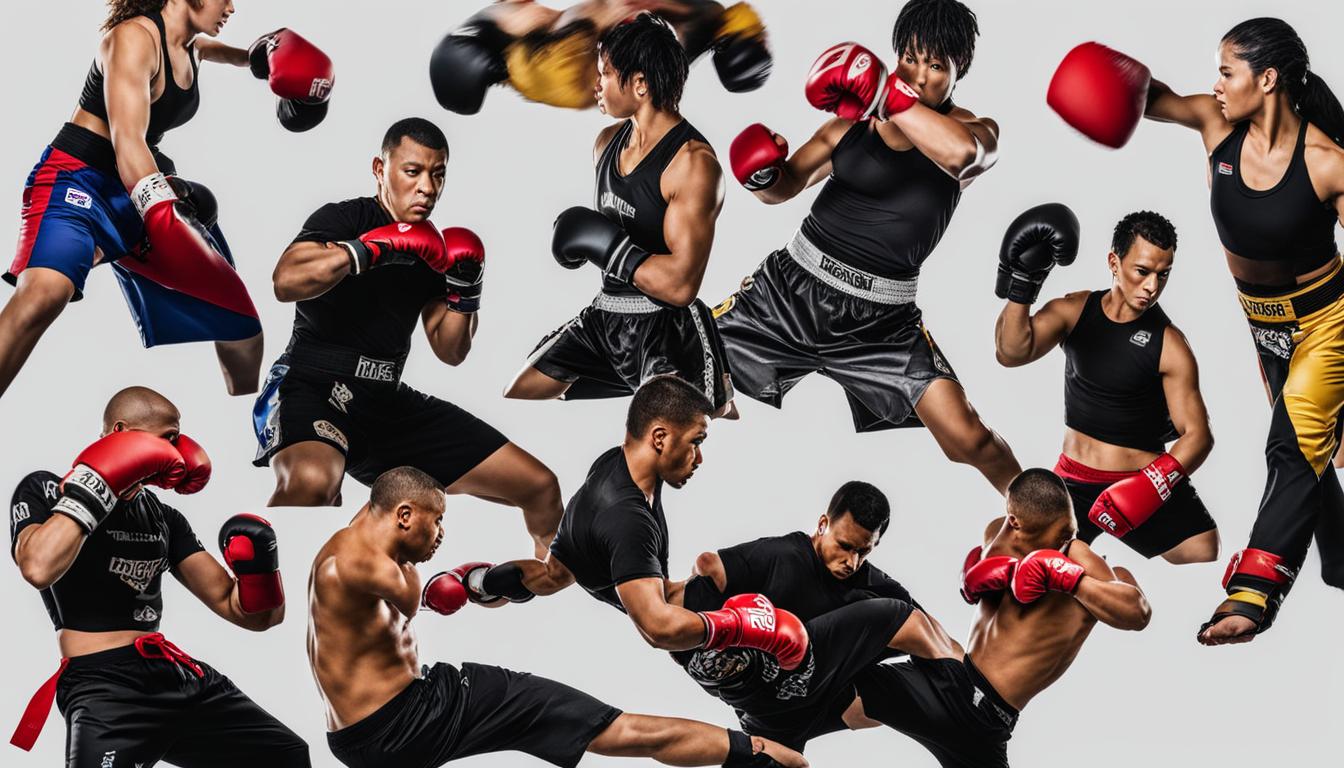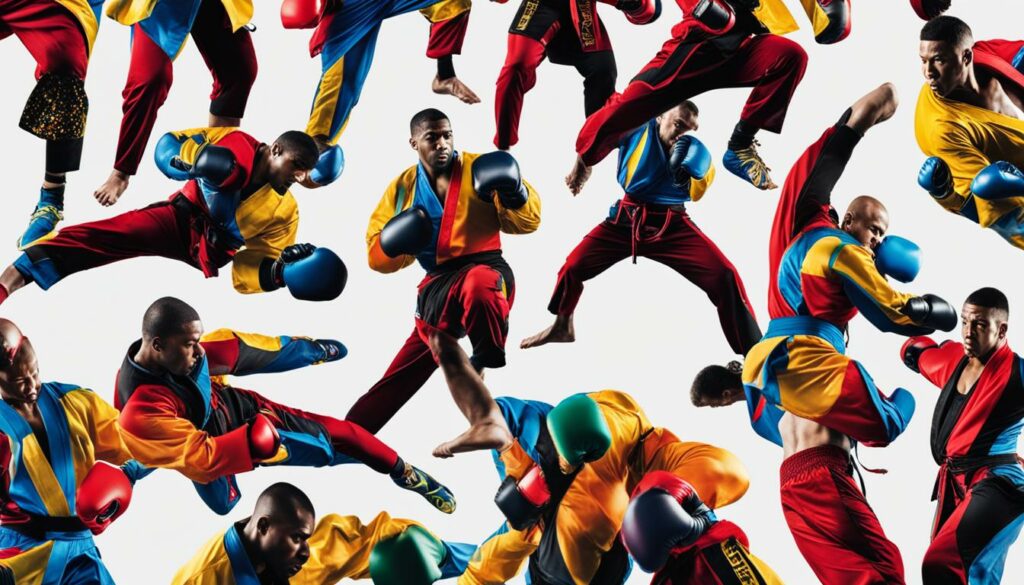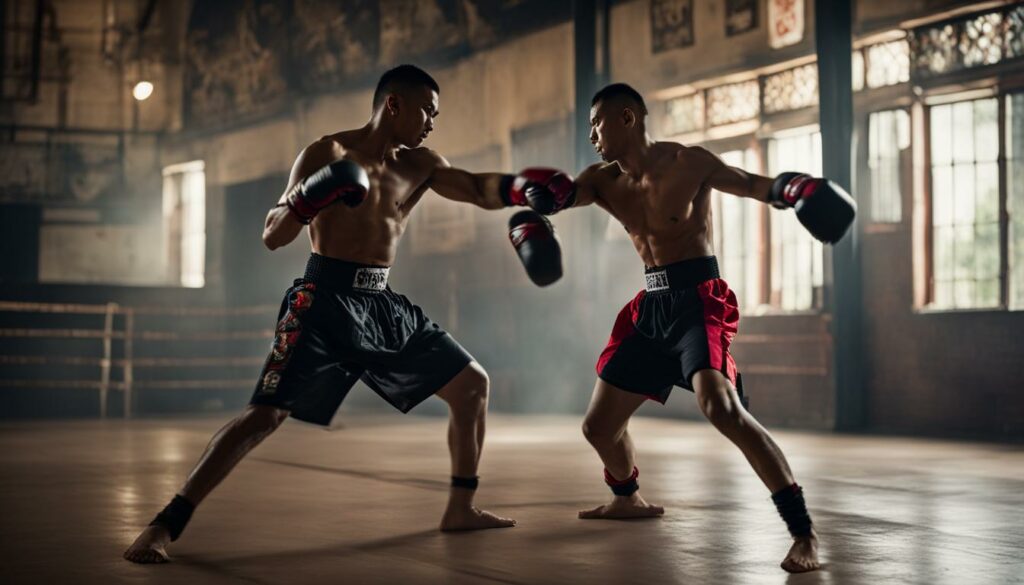Greetings! I’m excited to delve into the world of kickboxing with you. Kickboxing is a captivating combat sport that combines the art of punching and kicking. Today, I’ll be shedding light on the various styles of kickboxing and their unique techniques.
Traditional kickboxing encompasses styles such as Karate, Japanese kickboxing, and Savate. These time-honored practices have their roots in different parts of the world and offer a wealth of striking techniques and strategies.
On the other hand, we have modern kickboxing styles such as Muay Thai, Dutch kickboxing, and American kickboxing. These styles incorporate elements from various martial arts and have gained immense popularity worldwide.
In addition, we’ll explore full-contact kickboxing, where fighters engage in high-intensity action to knock out their opponents, as well as low-kick kickboxing, which focuses on targeting the lower body with powerful strikes.
Throughout the article, I’ll also touch upon the influence of these styles on the development of kickboxing as a whole and its impact on hybrid martial arts like MMA.
Are you ready to discover the fascinating world of kickboxing with me?
Key Takeaways
- Kickboxing encompasses different styles, including traditional and modern approaches.
- Traditional kickboxing styles include Karate, Japanese kickboxing, and Savate.
- Modern kickboxing styles include Muay Thai, Dutch kickboxing, and American kickboxing.
- Full-contact kickboxing emphasizes aggressive fighting with the goal of knocking out opponents.
- Low-kick kickboxing focuses on striking the lower body, particularly the legs.
Traditional Kickboxing Styles
When exploring the world of kickboxing, it is important to understand the rich history and varied styles that have shaped the sport. Traditional kickboxing styles, such as Karate, Japanese kickboxing, and Savate, showcase different techniques and approaches to combat.
Karate
Karate, originating in Japan, is one of the most well-known traditional kickboxing styles. It emphasizes strikes using punches, kicks, and knee strikes, with practitioners focusing on powerful and precise techniques. The philosophy of Karate extends beyond physical combat, instilling discipline, respect, and self-improvement.
Japanese Kickboxing (K-1)
Japanese kickboxing, also known as K-1, is a hybrid martial art that combines techniques from Karate, Muay Thai, and Western boxing. This style incorporates striking techniques such as punches, kicks, knees, and elbows, creating a dynamic and versatile approach to combat. K-1 gained popularity through its exciting tournaments and showcases of skill.
Savate
Savate, otherwise known as French kickboxing, has a fascinating history that dates back to the 19th century. Originating in France, it is characterized by its foot-kicking techniques, which include both kicking and striking with the feet. Savate combines elements of boxing and various French martial arts, resulting in a unique and elegant style of kickboxing.
“The traditional kickboxing styles of Karate, Japanese kickboxing, and Savate showcase the diversity of techniques and cultural influences within the world of kickboxing.” – Unveiled Kickboxing Magazine
| Traditional Kickboxing Styles | Origin | Key Techniques |
|---|---|---|
| Karate | Japan | Punches, Kicks, Knee Strikes |
| Japanese Kickboxing (K-1) | Japan | Punches, Kicks, Knee Strikes, Elbows |
| Savate | France | Foot-Kicking Techniques, Strikes, Boxing |
Modern Kickboxing Styles
When it comes to modern kickboxing styles, there are three prominent ones that have gained popularity worldwide. These styles include Muay Thai kickboxing, Dutch kickboxing, and American kickboxing.
Muay Thai kickboxing: Originating in Thailand, Muay Thai kickboxing is often referred to as “The Art of Eight Limbs.” This style emphasizes the use of fists, elbows, knees, and shins to deliver strikes. Known for its powerful and devastating techniques, Muay Thai is a favorite among professional fighters and enthusiasts alike.
Dutch kickboxing: Dutch kickboxing is a hybrid martial art that incorporates elements from Muay Thai, boxing, and Karate. It is known for its high level of technical skill and strategic approach to fighting. Dutch fighters are recognized for their precision, speed, and ability to seamlessly blend different techniques.
American kickboxing: Emerged in the 1970s, American kickboxing gained prominence with the first World Championships held in 1974. This style focuses on a combination of punches, kicks, and knee strikes. American kickboxing incorporates techniques from various martial arts, making it a versatile and dynamic style.
If you’re considering kickboxing as a sport or looking to train in a specific style, it’s important to explore the characteristics and techniques of these modern kickboxing styles. Each style offers its own unique strategies and approaches to combat, allowing fighters to develop their skills and find their personal strengths.
Comparison of Modern Kickboxing Styles
| Kickboxing Style | Origin | Key Techniques | Famous Fighters |
|---|---|---|---|
| Muay Thai kickboxing | Thailand | Fists, elbows, knees, shins | Buakaw Banchamek, Saenchai, Yodsanklai Fairtex |
| Dutch kickboxing | Netherlands | Striking combinations, footwork, feints | Rico Verhoeven, Badr Hari, Nieky Holzken |
| American kickboxing | United States | Punches, kicks, knee strikes | Joe Lewis, Bill Wallace, Don Wilson |
Full-Contact Kickboxing
Full-contact kickboxing is a thrilling and intense variation of the sport where fighters engage in non-stop, high-intensity action. The primary objective is to knock out opponents using a combination of powerful strikes and aggressive fighting styles.
In full-contact kickboxing bouts, fighters showcase their skills, strength, and speed as they unleash a flurry of punches, kicks, elbows, and knees. The action is fast-paced, and fighters continuously push their limits to gain the upper hand and emerge victorious.
This style of kickboxing is highly demanding, both physically and mentally. Fighters undergo rigorous training to develop their techniques, endurance, and discipline. They focus on honing their striking precision, speed, and power to deliver devastating blows to their opponents.
Full-contact kickboxing is prominently featured in various professional kickboxing organizations and promotions worldwide. These events attract a passionate fan base who appreciate the electrifying displays of skill and athleticism from the fighters.
Full-contact kickboxing is a thrilling and high-octane combat sport that showcases the raw power and determination of its participants. It’s a test of strength, strategy, and resilience, making it an exhilarating spectacle for both fighters and spectators alike.
Low-Kick Kickboxing
In the world of kickboxing, there is a style that focuses on delivering powerful strikes to the lower body – low-kick kickboxing. Also known as leg kick kickboxing, this style is all about targeting the thighs and shins of opponents to weaken them. Fighters who specialize in low-kick kickboxing employ a combination of precision, technique, and strength to execute devastating kicks that can turn the tide of a bout.
Low-kick kickboxing has found its place in various kickboxing competitions, most notably in the realm of Muay Thai, where leg kicks are a key component of the fighting style. By strategically striking the legs, fighters aim to impair their opponents’ mobility, limit their ability to generate power, and ultimately gain an advantage in the match.
When it comes to low-kick kickboxing, proper technique and conditioning are of utmost importance. Fighters must train diligently to strengthen their legs, ensuring that their kicks are powerful and accurate. In addition to the physical aspect, low-kick kickboxing also requires mental agility and tactical awareness to effectively execute leg kicks at opportune moments during a fight.
Low-kick kickboxing is a testament to the versatility and diversity of kickboxing as a combat sport. It showcases the adaptability of fighters, who can excel in different styles, whether it be the precise strikes of traditional kickboxing or the raw power of full-contact kickboxing. With its focus on leg kicks, low-kick kickboxing adds yet another dimension to the world of kickboxing, providing fans and fighters alike with thrilling displays of skill and strategy.
Join me in the next section, where we will explore the influence of different kickboxing styles on the evolution of the sport.
The Influence of Different Styles on Kickboxing
Different styles of kickboxing have played a significant role in shaping and evolving the sport. They have not only contributed to the development of kickboxing as a standalone combat discipline but have also influenced the emergence of hybrid martial arts, such as mixed martial arts (MMA).
Kickboxing’s fusion with ground fighting techniques from Brazilian jiu-jitsu and folk wrestling has paved the way for the evolution of modern MMA. By incorporating elements from various traditional styles, kickboxing has become a versatile and dynamic combat sport.
One of the key influences of different kickboxing styles can be seen in the striking techniques employed by fighters. Each style brings its own unique approach to punches, kicks, and knee strikes, resulting in a diverse range of offensive and defensive maneuvers.
In addition to striking techniques, different styles of kickboxing also vary in terms of footwork, movement, and defensive strategies. These variations have contributed to the development of a wide array of fighting styles within the kickboxing community.
For example, traditional kickboxing styles like Karate and Japanese kickboxing have influenced the use of precise and disciplined movements. On the other hand, modern kickboxing styles such as Muay Thai kickboxing and Dutch kickboxing have emphasized the use of forceful strikes and aggressive fighting techniques.
The influence of different kickboxing styles goes beyond the technical aspects of the sport. It has shaped the mentality and training methods of kickboxers, instilling in them a combination of discipline, resilience, and adaptability.
Furthermore, the influence of different styles has contributed to the growth and popularity of kickboxing as a global sport. Fighters from various backgrounds and styles come together to test their skills and showcase their unique approaches in professional kickboxing competitions.
| Kickboxing Style | Key Influences |
|---|---|
| Karate | Japanese martial arts, precise striking techniques |
| Japanese kickboxing | Karate, Muay Thai, Western boxing |
| Muay Thai kickboxing | Traditional Muay Thai, eight-limbed striking |
| Dutch kickboxing | Muay Thai, boxing, Karate |
In conclusion, the influence of different kickboxing styles on the sport’s development cannot be overstated. Not only have these styles shaped the technical aspects of kickboxing, but they have also contributed to the growth and popularity of the sport. The combination of elements from various styles has resulted in a diverse and exciting combat sport that continues to captivate audiences worldwide.
Conclusion
After delving into the different styles of kickboxing, it becomes apparent that this sport offers a rich history and a wide range of techniques and strategies. Traditional styles like Karate and Japanese kickboxing showcase the influence of Eastern martial arts, emphasizing striking techniques with punches, kicks, and knee strikes. On the other hand, modern styles such as Muay Thai and Dutch kickboxing have emerged with their own unique blends of techniques, incorporating elements from various disciplines like boxing and Karate.
Whether it’s the full-contact intensity of kickboxing or the precise targeting of low-kick kickboxing, the sport continues to captivate and inspire fighters worldwide. Each style of kickboxing brings its own flavor and challenges, providing athletes with endless opportunities for growth and development.
Furthermore, the influence of kickboxing on hybrid martial arts, such as mixed martial arts (MMA), cannot be understated. The combination of techniques from different styles has played a significant role in shaping the modern combat sports landscape. This fusion has not only expanded the possibilities for fighters but has also created a platform for fans around the world to witness the evolution of martial arts.
In conclusion, kickboxing’s diverse range of styles, from traditional to modern, showcases the evolution and versatility of the sport. With its rich history and ongoing development, kickboxing remains an exciting and dynamic discipline that continues to attract practitioners and spectators alike.



